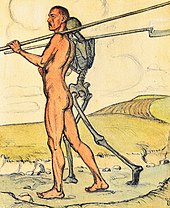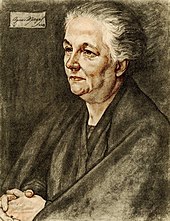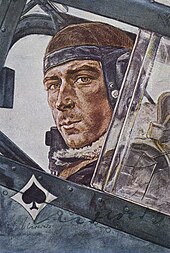Wolfgang Willrich
Wolfgang Willrich (born March 31, 1897 in Göttingen ; † October 18, 1948 there ) was a German artist and writer. From 1927 to 1930 he was a supporter of Erich Ludendorff's Völkischer Tannenbergbund . In 1934 Willrich joined the SS as a supporting member . Willrich is considered a fanatical representative of National Socialist art policy. He is one of the organizers of the National Socialist exhibition Degenerate Art and was authorized by the Gestapo to confiscate pictures in German museums.
family




Willrich was born on March 31, 1897 in Göttingen . His father was the ancient historian Hugo Willrich , who came from a traditional family . On his mother's side he came from an old Lower Saxon family named Jacobi . Willrich grew up with two sisters.
On December 29, 1931, Willrich married Charlotte Herber, with whom he had three children.
Artistic activity
Willrich contributed his own pictures to National Socialist exhibitions such as the "Great German Art Exhibition" in the Nazi state . His pictures heroized the "Nordic people" and later German soldiers. Since the First World War, Willrich has seen his life's mission in depicting the “Nordic man”. Willrich felt called to represent the type of person who, in his opinion, made “the heaviest blood sacrifices” in the world war. He describes his development as a move towards “race and art”. Willrich received his artistic training at the Dresden Academy of Fine Arts , where he studied from 1920 to 1927. He devoted his entire training to the portrayal of the "Nordic man". Willrich received numerous awards during his studies. On April 18, 1923, his large-format triptych (7.10 × 3 m) for the auditorium of the Max-Planck-Gymnasium Göttingen was given to the school to honor those who fell in the World War. The people on the triptych bear the features of the school’s students and teachers who died in the World War. Willrich then studied biology from 1927 to 1931. Willrich experienced his breakthrough when Nazi Minister Walter Darré brought him to Berlin on May 12, 1934 for the "artistic design of the state concept of blood and soil".
In search of models for his pictures, Willrich traveled extensively through Germany and Austria. Willrich's trips were financed by the Race and Settlement Main Office of the SS and the Race Political Office of the NSDAP . According to Willrich, the task of art is to artistically represent the “racial idea”. So Willrich 1937: “The racial idea strives for public health, racial purity and eternity of the German people. Visual arts can spread and impress it even better than words. ”At the exhibition“ German Artists and the SS ”in 1944 in Breslau his picture“ Blessing of the Earth ”was exhibited, the catalog commented on it with the text“ In this young Nordic female figure WW reveals the simple species awareness of German peasantry ”. Willrich also created well-known portraits of military celebrities such as Erich Raeder and Erwin Rommel in 1941 .
Willrich published articles on art on racial ideology in a number of Nazi magazines, for example in Volk und Rasse , Odal , monthly for blood and soil , Das Schwarze Korps or Rasse, monthly for the Nordic movement .
From 1934 to 1938 he gave lectures on National Socialist racial doctrine at the HJ Reichsführer-School in Potsdam. In 1938 he gave up his lecturing activity after he saw no more support for his lectures in the Reich Youth Leadership and his sponsor Paul Minke had been deposed as head of the school. When Heinrich Himmler himself Willrich complained about the Reich leadership as a whole and the treatment of some of his paintings, which he had exhibited at the HJ Reich Leadership School in Potsdam. He complained that Reich Youth Leader Baldur von Schirach tried to ridicule his lectures in front of the HJ and BDM leaders. At the HJ Reichsführer-School he came into contact with Walter Hansen, who was feared as an informer within the NSDAP and who ostracized modern art even more radically than Willrich.
Willrich and the "degenerate art"
In January 1937, Willrich published "Cleansing the German Temple of Art - An art-political combat pamphlet for the recovery of German art in a Nordic spirit". This inflammatory pamphlet is seen today as an important template for the design and planning of the National Socialist exhibition “Degenerate Art” in Munich. Large parts of the book, however, did not come from Willrich's pen, but were presumably written by Walter Hansen. On April 2, 1937, Hansen and Willrich were commissioned by the Reich Ministry of Propaganda to select pictures for the “Degenerate Art” exhibition. They were given powers of attorney from the Gestapo that authorized them to confiscate pictures from art collections throughout the Reich. In the course of their work, they encountered resistance from numerous museum directors. Willrich got into an argument with Adolf Ziegler in particular , since Willrich also selected works of art that had been created by members of the Kunstkammer . Willrich's rigorous, defamatory and racist exhibition design gave the National Socialist art policy an additional hardness in relation to any modern art movement. On July 5, 1937, Willrich took part in the confiscation of works of art classified as “degenerate” in the Hamburger Kunsthalle .
The Gottfried Benn case
In his book, Willrich agitated against the poet Gottfried Benn , whom he accused of being a "cultural Bolshevik". Before that, Benn had been sharply attacked by the Nazi magazines Das Schwarze Korps and Völkischer Beobachter . Benn then complained to Willrich's publisher, JF Lehmanns Verlag in Munich. Willrich responded with a letter dated August 27, 1937, which, as an expression of Willrich's disdain, did not contain any form of address or letter ending. On the same day, Willrich reported Benn to Walter Darré as a "danger to the SS and the Reichsbauernrat". Heinrich Himmler admonished Willrich that although he appreciated his work against “degenerate” art, it should not become “the purpose of life and run amok” for Willrich. Himmler said that it was more important that Willrich continue to paint “good pictures” than to slander any artist who has once created “stupid things”.
Second world war and end of war
During the Second World War , Willrich was a member of propaganda companies from August 1940 and two years later he worked for the propaganda substitute department “Staffel der Bildenden Künstler”. At or after the end of the war, Willrich was interned in the United States in Göttingen, from which he was released in 1946.
In the Soviet occupation zone , Willrich's writings on Art and Public Health (Reich Committee for Public Health Service, Berlin 1934), Peasantry as Heger German Blood (Blut und Boden Verlag, Goslar 1935), The Tree of Life German Art. Pictures and Thoughts on the Race Question (Blut und Boden Verlag, Goslar 1937), Das deutsche Antlitz (Verlag Sigrune, Erfurt 1938), Cleansing the Art Temple ( Lehmann , Munich 1938), The men of our submarine weapon (Verlag Grenz und Abroad, Berlin 1939), The men of our air force (Verl. Frontier and Abroad, Berlin 1940), Des Noble Eternal Reich (Verl. Frontier and Abroad, Berlin 1941) and Des Empire Soldiers (Verl. Frontier and Abroad, Berlin 1943) put on the list of literature to be sorted out.
Fonts
- Nature and shape of the Germanic man . In: Odal. Monthly for Blood and Soil , Vol. 2, Issue 12, June 1934, pp. 889–902.
- Beauty as a form expression of high quality . In: Odal. Monthly for Blood and Soil , Vol. 3, 1934, Issue 2, pp. 132-133.
literature
- Ernst Klee : The cultural lexicon for the Third Reich. Who was what before and after 1945. S. Fischer, Frankfurt am Main 2007, ISBN 978-3-10-039326-5 .
Web links
- Literature by and about Wolfgang Willrich in the catalog of the German National Library
- North Frisian young farmers in the "Great German Art Exhibition" 1939 (there also 30 other works)
- Page of the Willrich archive with over 950 images
Individual evidence
- ↑ http://wolfgang-willrich.de/page/lebensdaten.php
- ↑ http://wolfgang-willrich.de/page/lebensdaten.php
- ↑ http://wolfgang-willrich.de/page/lebensdaten.php
- ↑ http://wolfgang-willrich.de/page/lebensdaten.php
- ↑ Wolfgang Willrich: My way and my attitude to race and art, in: Volk und Rasse 1934, p. 103 f.
- ^ Hansen, Walter: Wolfgang Willrich, in: Das Bild. Monthly magazine for German art in the past u. Present 1936, p. 332.
- ↑ Trittel, Dorothea: Abgehangedes Gedenken. The auditorium in the Max-Planck-Gymnasium, in: Gottschalk, Carola (ed.): Eternal and forget. War memorials, memorials and memorial stones in Göttingen. Göttingen 1992, p. 71 f.
- ↑ http://wolfgang-willrich.de/page/lebensdaten.php
- ↑ Hansen, Willrich, p. 332.
- ↑ http://wolfgang-willrich.de/page/lebensdaten.php
- ↑ Wolfgang Willrich: Letter to Richard Walther Darré dated November 1, 1936, quoted from: Wulf, Joseph, Die bildenden Künste im Third Reich. A documentation, Frankfurt / M., Berlin 1989, pp. 390–392.
- ↑ Willrich, Wolfgang: Letter to Richard Walther Darré of October 4, 1938, quoted from: Wulf, Bildende Künste, pp. 178-180.
- ↑ Wolfgang Willrich: The cleaning of the temple of art - an art-political combat pamphlet for the recovery of German art in the spirit of Nordic art. Munich / Berlin 1937, p. 144.
- ^ German artists and the SS , exhibition catalog, Breslau 1944.
- ↑ a b c d Ernst Klee: The culture lexicon for the Third Reich. Who was what before and after 1945. S. Fischer, Frankfurt am Main 2007, p. 600.
- ↑ http://wolfgang-willrich.de/page/bibliografie/von-willrich/aufsaetze.php
- ↑ http://wolfgang-willrich.de/page/lebensdaten.php
- ↑ Willrich, Wolfgang: Letter to Heinrich Himmler from November 2, 1938, quoted from: Wulf, Bildende Künste, p. 394 f.
- ^ Ernst Klee: The culture lexicon for the Third Reich. Who was what before and after 1945. S. Fischer, Frankfurt am Main 2007, p. 215.
- ↑ http://wolfgang-willrich.de/page/lebensdaten.php
- ↑ Wulf, Bildende Künste, p. 401 f.
- ↑ Willrich, Wolfgang: Report to Richard Walter Darré of April 30, 1937, quoted from: Wulf, Bildende Künste, pp. 351–354.
- ↑ Wulf, Joseph: Literature and Poetry in the Third Reich. A documentation., Frankfurt / M, Berlin 1989, p. 136.
- ↑ Wulf: Literature, p. 140.
- ↑ Willrich, Wolfgang: Letter to Richard Walter Darré of August 27, 1937, quoted from: Wulf, Literatur, p. 142 f.
- ^ Himmler, Heinrich: Letter to Wolfgang Willrich of September 18, 1937, quoted from: Wulf, Literatur, p. 143 f.
- ^ German administration for popular education in the Soviet occupation zone, list of literature to be sorted out 1946
- ^ German administration for popular education in the Soviet occupation zone, list of literature to be sorted out 1947
- ^ German administration for popular education in the Soviet occupation zone, list of literature to be sorted out 1948
| personal data | |
|---|---|
| SURNAME | Willrich, Wolfgang |
| BRIEF DESCRIPTION | German artist and writer during the Nazi era |
| DATE OF BIRTH | March 31, 1897 |
| PLACE OF BIRTH | Goettingen |
| DATE OF DEATH | October 18, 1948 |
| Place of death | Goettingen |